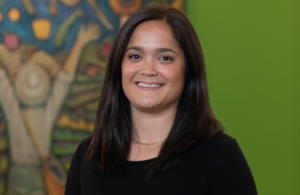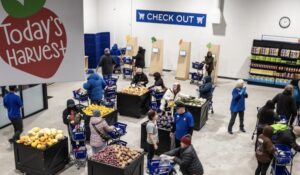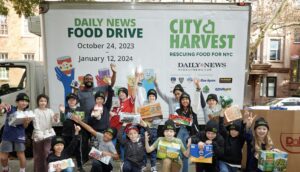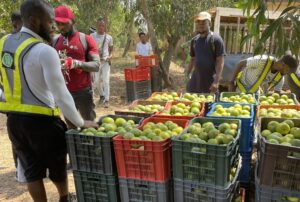Community Solidarity is not a food bank, though it does the work of one. It’s more like a radical food rescuer, popping up in flash-mob fashion around Long Island and Brooklyn atop a loose infrastructure of volunteers, folding tables and produce. There is no warehouse, no fleet of trucks, and barely a budget, yet last year Community Solidarity managed to distribute more than six million pounds of healthy, vegetarian food.
Long Island native Jon Stepanian, President and CEO, planted the seeds for Community Solidarity 13 years ago when he was struggling with unemployment following college graduation. Simply as a way to feel better, he and his friends began handing out a few loaves of bread rescued from Trader Joe’s in the parking lot of a local train station. Last year at the same location, on the Sunday before Thanksgiving, Community Solidarity served 137,000 pounds of food to 6,100 people. In all of last year, it gave out 6.25 million pounds at five different locations. Only vegetarian food — including fresh produce, bread and some dairy — is distributed, in keeping with Stepanian’s beliefs related to compassionate eating.

Community Solidarity’s impressive growth has been powered by its volunteer network, which encompasses 3,100 individuals, including more than 100 who put in more than 20 hours a week. Volunteers have logged 270,000 miles on their own vehicles, picking up food from local grocery stores and delivering it to distribution points within hours. They’ve never missed a distribution, even during Hurricane Sandy and its aftermath. “Our volunteers are the backbone,” Stepanian said.
Stepanian doesn’t use a SignUpGenius or any kind of formal task list to engage the volunteers or manage their activities. Rather, the strength of the network stems from the open and accepting atmosphere Stepanian has created: many of the volunteers also come to pick up food, or may have in the past. Usually hot vegan food is also available, as well as clothing and household goods, lending a flea-market — or even festival-like — feel to the distributions.
“There’s no line of demarcation between those who are volunteering and those who are getting groceries,” Stepanian said. “The whole point of this is to make a space for people to help out. Most people want to help out in some way. That’s why we call it Community Solidarity.”
With so many volunteers, there’s no option but to let the operation run in a decentralized fashion. “With that many volunteers, you have to let it go,” Stepanian said. “You can’t control it.” Nor does he want to. “People need the autonomy to make it theirs,” he said. “And if you give people voice, it’s going to change the way they participate.”
Besides being the fuel of the operation, Community Solidarity’s committed volunteer network helps bring costs way down. Community Solidarity’s budget was about $60,000 last year, and was mostly spent on required administrative fees. Admittedly, the group’s approach to staffing is unusual. Stepanian is the sole paid staff member and his salary, which he only began taking this year, is “comical,” he said.
The group relies heavily on technology, using an app it created to coordinate and route volunteers. Donations are generally picked up within about two hours of a call, and then distributed within three hours. “We’re like the Uber of food rescue,” Stepanian said.
In addition to creating a record of donated food for the grocery stores, the app logs the nutritional value of the food being picked up. Just for good measure, it also calculates the carbon footprint of the volunteers in their cars, and how much of it is offset by the rescued food. And more. “There are more metrics than you could ever imagine,” Stepanian said.
Community Solidarity does not require anyone to sign in or register to get food, so it also uses technology to figure out how many people are coming to its distributions. By taking a photo of a distribution, for example, it can use image processing software to see how many individual faces are at the location. It also uses cell phone activity to gauge how busy a location is. Sometimes it just extrapolates, figuring how many lines have formed, about how many people are in the lines, and how long the lines last.
Stepanian would like to bring the Community Solidarity style of food distribution, including its app, to other parts of the country, though that would require additional funding to support requirements like administrative filings in other states and computer servers to run the app. “We want to grow bigger,” Stepanian said. “One day, I’d love to be all across the country.”
One thing that would not be a problem is finding enough food, which is in ample supply everywhere. In Stepanian’s view, current estimates of food waste are “ridiculously low.” And as he points out in his TEDxNYU Talk, the same type of waste related to food is happening with all types of goods, from clothing to office supplies.
The only limit to being able to feed everyone who’s hungry is simply the number of volunteers with vehicles who can help. “I do think the solution is much easier than people imagine,” Stepanian said. “It’s not an impossible problem to fix.”
ABOVE: Jon Stepanian at a Community Solidarity distribution in Hempstead, NY.














